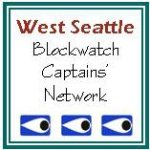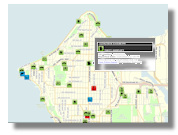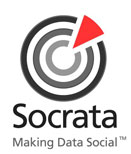 This past Tuesday night, there were 1,219 parties in the street all around Seattle. Kids, hot dogs, drinks, cops and firefighters and neighbors everywhere. It was part of the National Night Out. And it was, perhaps, one of the last in Seattle, as the City may cut the jobs of six or seven crime coordinators responsible for the Blockwatch program.
This past Tuesday night, there were 1,219 parties in the street all around Seattle. Kids, hot dogs, drinks, cops and firefighters and neighbors everywhere. It was part of the National Night Out. And it was, perhaps, one of the last in Seattle, as the City may cut the jobs of six or seven crime coordinators responsible for the Blockwatch program.
Blockwatch programs are a widespread form of civic engagement. And they’ve morphed over the years adopting technology to become more effective. Now the combination of the Great Recession, the Great Budget Crisis and the explosion of social media such as Facebook, they are likely to morph again into a new and cool form of civic engagement, if we can maintain the thin blue line of civilians who run the programs.
Blockwatches, often called neighborhood watches, are a staple of many communities across the United States. I talked to Terrie Johnston, a crime prevention coordinator and 30 year employee in the Seattle Police Department, and she gave me some history of Blockwatches in the Seattle PD. This history is typical of Blockwatches across the nation and Canada.
Often a Blockwatch starts around a particular incident in a neighborhood. Sometimes it is a series of burglaries, or perhaps a drive-by shooting, or an incident near a school. One or more people in a neighborhood get concerned enough to call the local police precinct or Seattle Crime Prevention. The crime prevention coordinator sets up a meeting with the neighbors, discusses the incident and related crimes, and gives the neighbors hints, tips and advice on how to be watchful and protect each other.
Amazingly, Terrie says, it is young families with children who often initiate the Blockwatch or get involved to protect their families. I say “amazingly” because it is this demographic – young people who have kids and very busy lives, often with two jobs – who are hard to get involved in public meetings with City officials. Not so with the Blockwatch!
From this beginning, Blockwatches progress in a variety of ways. Many become social groups as well as crime prevention tools. In my neighborhood we have an e-mail list, we get together for a Christmas party, we even watched the Presidential debates of 2008.
In most Seattle neighborhoods, the Blockwatches also organize themselves into a SNAP (Seattle Neighborhoods Actively Prepare) team. Seattle will have a major earthquake in the future. Such a quake – perhaps at 8 or even 9 on the Richter scale – will mean many neighborhoods may be isolated and have to survive on their own for many days. Neighbors need caches of food and water, need to know first aid and light search and rescue. Neighbors need to help each other.
There are probably a thousand active blockwatches in Seattle, but the Seattle Police crime coordinators have a list of 4000 blockwatch contacts.
The crime coordinators actively stay in touch with their Blockwatch contacts. Originally this contact was by conducting meetings and handing out fliers or maps of recent crimes. While they still attend meetings, make phone calls and hand out paper, the coordinators have also adapted technology. By far the most common method of contact now is e-mail, and they’ll email hints and tips or alerts to their Blockwatch Captains and contacts.
The most active Captains themselves will suggest alerts and updates – for example alerting neighbors to a Memorial Day observance at a military cemetery which included gunshots – a 21 gun salute. Every precinct has a blog and web page for crime prevention.
 Just within the last year the City of Seattle and Seattle Police have developed a whole series of new online tools to improve the effectiveness of crime prevention. There’s now an online tool which allows residents to map almost all the crimes in their neighborhood (domestic violence and a few others are excluded). The map also allows people to actually download and view the actual redacted police report for many of these crimes. Just last week mapping of Police 911 calls debuted on the website, added to the mapping of Seattle Fire 911 calls which has been available for 6 years or more. Also last week a new crime reporting function was added to the Seattle.gov web, so residents can file reports online for minor crimes such as thefts under $500 or car prowls or similar incidents where they don’t need to talk to a police officer.
Just within the last year the City of Seattle and Seattle Police have developed a whole series of new online tools to improve the effectiveness of crime prevention. There’s now an online tool which allows residents to map almost all the crimes in their neighborhood (domestic violence and a few others are excluded). The map also allows people to actually download and view the actual redacted police report for many of these crimes. Just last week mapping of Police 911 calls debuted on the website, added to the mapping of Seattle Fire 911 calls which has been available for 6 years or more. Also last week a new crime reporting function was added to the Seattle.gov web, so residents can file reports online for minor crimes such as thefts under $500 or car prowls or similar incidents where they don’t need to talk to a police officer.
Seattle departments – including Police, Fire and others, have adapted twitter to rapidly inform residents of incidents as they occur. The Seattle website also includes a series of fifteen interlinked blogs called CityLink. On the Police blog, called spdblotter.seattle.gov, more detail is given on crimes and other incidents which the Police also tweet .
There are many organizations which operate in every neighborhood. Besides Blockwatches, there are district councils, and arts organizations and community development groups, not to mention an active set of privately operated neighborhood blogs which have, in many ways, taken over the functions formerly performed by community newspapers. The City has an index of all these resources on its website, Neighborhoods on the Net.
I think Blockwatches may morph in two ways in the future – first expanding their function and also changing their method of communication to use social media.
In terms of function, traditionally some Blockwatches have morphed from crime prevention to community engagement. They actively advocate for cleaning up derelict properties, eliminating graffiti, calming traffic (adding speed bumps or traffic circles) and of course caring for each other, e.g. checking in on the elderly or disabled.
But the City hasn’t always adopted the power of the Blockwatch movement for other forms of civic engagement. Many City departments go to neighborhoods and hold public meetings to gain input on zoning changes or neighborhood plan updates or changing the configuration of an arterial street to add turning lanes or bike lanes. But those meetings tend to be “one shot” deals or tend to use or create new e-mailing lists. Rarely do the other departments take advantage of the existing power of the organized Blockwatches. And often the City doesn’t actually give feedback to neighborhoods about how their input was used.
In these days of constrained resources, Blockwatches can and should morph from just crime prevention, to community involvement groups – “Citywatches”.
To do this, municipal governments need to find ways to adapt social media to Blockwatches and community engagement.
Facebook has taken the Internet by storm, with over half-a-billion users. It seems to be a natural new way for Blockwatches to post news, communicate and interact both internally, with other Blockwatches and with police departments and other City functions.
But Facebook as a company doesn’t “play nice” with government or other companies, in that it is hard for governments to save Facebook entries and comments, thereby complying with State records retention laws and FOIA laws. Furthermore, it is hard – if not impossible – to create a set of “blockwatch neighbors” separate and distinct from other groups and friends, and keep that group private, only sharing selected updates with other groups or the municipal government.
Facebook’s great advantage for this purpose is that so many people use it – they don’t have to learn or adopt some new tool. Other social media tools also hold promise for the future of Blockwatches and Citywatches. These include, perhaps, Wiki’s for sharing information about neighborhoods, Ideascale or Uservoice tools such as Ideas For Seattle to generate and rank ideas on certain topics, and Twitter.
A common problem – especially with Twitter and Blogs and Facebook – is easily capturing and harvesting comments or tweets so the Blockwatch captain or appropriate City department can adequately respond. Smartphone applications are already used by governments for JAPA (just another pothole application) feedback, but haven’t been widely used in public meetings, e.g. making comments and what is being said or voting during public meetings, which can improve the level of involvement among the audience. Certainly many governments are afraid of being overwhelmed by input which underscores the need for tools or software to harvest and consolidate responses.
Seattle has asked Code for America, the new non-profit founded by Tim O’Reilly, for help in developing a solution to improving Blockwatches via such social media tools, and thereby helping them to evolve into new platforms for civic action and engagement. With some luck, such a solution can be developed and used by many local governments across the nation.
Finally, I will admit and lament that personal interaction among neighbors has declined. The many time pressures on families mean we have less time to simply talk to our neighbors. But all these new smartphone, social media, technology tools can help improve that interaction.
Fundamentally, however they only supplement the face-to-face Blockwatch meeting which builds community and trust, so neighbors truly care about and watch out for each other.

 As Gnomedex winds down on Saturday at 5:00 PM, the Open Government Hackathon winds up. The Hackathon is sponsored by two phenomenal local tech companies, Socrata and Tropo. Socrata has made its name making data open and transparent, most notably with data.gov and data.seattle.gov (well, and a few other sites).
As Gnomedex winds down on Saturday at 5:00 PM, the Open Government Hackathon winds up. The Hackathon is sponsored by two phenomenal local tech companies, Socrata and Tropo. Socrata has made its name making data open and transparent, most notably with data.gov and data.seattle.gov (well, and a few other sites). Read more about the Hackathon on Chris Pirillo’s blog here, or the Socrata blog here, or the Tropo blog here.
Read more about the Hackathon on Chris Pirillo’s blog here, or the Socrata blog here, or the Tropo blog here.



